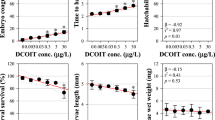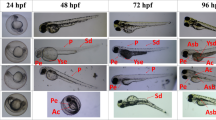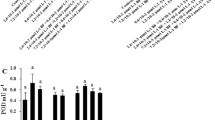Abstract
Avobenzone and octinoxate are frequently used as organic ultraviolet filters, and these chemicals are widely detected in water. This study evaluated the potential of avobenzone and octinoxate to disrupt thyroid endocrine system in wild-type and thyroid hormone receptor alpha a knockout (thrαa−/−) zebrafish embryo/larvae. Following a 120 h exposure to various concentrations of avobenzone and octinoxate, larvae mortality and developmental toxicity in wild-type and thrαa−/− fish were assessed. Triiodothyronine (T3) and thyroxine (T4) levels as well as transcriptional levels of ten genes associated with the hypothalamus-pituitary-thyroid (HPT) axis were measured in wild-type fish. Significantly lower larvae survival rate in thrαa−/− fish exposed to ≥3 μM avobenzone and octinoxate suggests that the thyroid hormone receptor plays a crucial role in the toxic effects of avobenzone and octinoxate. A significant increase in the deio2 gene level in avobenzone-exposed zebrafish supports the result of an increased ratio of T3 to T4. Significant decrease of T4 level with upregulation of trh, tshβ, and tshr genes indicates feedback in the hypothalamus and pituitary gland to maintain hormonal homeostasis. Our observation indicates that exposure to avobenzone and octinoxate affects the thyroid hormone receptor and the feedback mechanisms of the HPT axis.
Clinical trials registration
Not applicable.



Similar content being viewed by others
Data availability
All data generated or analyzed during this study are included in this published article and its supplementary data files.
References
Bratkovics S, Wirth E, Sapozhnikova Y, Pennington P, Sanger D (2015) Baseline monitoring of organic sunscreen compounds along South Carolina’s coastal marine environment. Mar Pollut Bull 101(1):370–377. https://doi.org/10.1016/j.marpolbul.2015.10.015
Chu S, Kwon BR, Lee YM, Zho KD, Choi K (2021) Effects of 2-ethylhexyl-4-methoxycinnamate (EHMC) on thyroid hormones and genes associated with thyroid, neurotoxic, and nephrotoxic responses in adult and larval zebrafish (Danio rerio). Chemosphere 263:128176. https://doi.org/10.1016/j.chemosphere.2020.128176
da Silva ACP, Santos BAMC, Castro HC, Rodrigues CR (2022) Ethylhexyl methoxycinnamate and butyl methoxydibenzoylmethane: toxicological effects on marine biota and human concerns. J Appl Toxicol 42(1):73–86. https://doi.org/10.1002/jat.4210
Deal CK, Volkoff H (2020) The role of the thyroid axisin fish. Front Endocrinol 11: 596585. https://doi.org/10.3389/fendo.2020.596585
Eales JG (2019) The relationship between ingested thyroid hormones, thyroid homeostasis and iodine metabolism in humans and teleost fish. Gen Comp Endocrinol 280:62–72. https://doi.org/10.1016/j.ygcen.2019.04.012
Ekpeghere KI, Kim UJ, O SH, Kim HY, Oh JE (2016) Distribution and seasonal occurrence of UV filters in rivers and wastewater treatment plants in Korea. Sci Total Environ 542:121–128. https://doi.org/10.1016/j.scitotenv.2015.10.033
Fent K, Zenker A, Rapp M (2010) Widespread occurrence of estrogenic UV-filters in aquatic ecosystems in Switzerland. Environ Pollut 158:1817–1824. https://doi.org/10.1016/j.envpol.2009.11.005
Holloway N, Riley B, MacKenzie DS (2021) Expression of the sodium iodide symporter (NIS) in reproductive and neural tissues of teleost fish. Gen Comp Endocrinol 300:113632. https://doi.org/10.1016/j.ygcen.2020.113632
Kameda Y, Kimura K, Miyazaki M (2011) Occurrence and profiles of organic sun-blocking agents in surface waters and sediments in Japanese rivers and lakes. Environ Pollut 159:1570–1576. https://doi.org/10.1016/j.envpol.2011.02.055
Klammer H, Schlecht C, Wuttke W, Schmutzler C, Gotthardt I, Köhrle J, Jarry H (2007) Effects of a 5-day treatment with the UV-filter octyl-methoxycinnamate (OMC) on the function of the hypothalamo-pituitary-thyroid function in rats. Toxicology 238:192–199. https://doi.org/10.1016/j.tox.2007.06.088
Klopčič I, Dolenc MS (2017) Endocrine activity of AVB, 2MR, BHA, and their mixtures. Toxicol Sci 156(1):240–251. https://doi.org/10.1093/toxsci/kfw253
Kullavanijaya P, Lim HW (2005) Photoprotection. J Am Acad Dermatol 52:937–958. https://doi.org/10.1016/j.jaad.2004.07.063
Labille J, Slomberg D, Catalano R, Robert S, Apers-Tremelo ML, Boudenne JL, Manasfi T, Radakovitch O (2020) Assessing UV filter inputs into beach waters during recreational activity: a field study of three French Mediterranean beaches from consumer survey to water analysis. Sci Total Environ 706:136010. https://doi.org/10.1016/j.scitotenv.2019.136010
Lee I, Lee J, Jung D, Kim S, Choi K (2019) Two-generation exposure to 2-ethylhexyl 4-methoxycinnamate (EHMC) in Japanese medaka (Oryzias latipes) and its reproduction and endocrine related effects. Chemosphere 228:478–484. https://doi.org/10.1016/j.chemosphere.2019.04.123
Lee J, Kim S, Park YJ, Moon HB, Choi K (2018) Thyroid hormone-disrupting potentials of major benzophenones in two cell lines (GH3 and FRTL-5) and embryo-larval zebrafish. Environ Sci Technol 52(15):8858–8865. https://doi.org/10.1021/acs.est.8b01796
Livak KJ, Schmittgen TD (2001) Analysis of relative gene expression data using real-time quantitative PCR and the 2(-delta delta C(T)) method. Methods 25(4):402–408. https://doi.org/10.1006/meth.2001.1262
Nataraj B, Maharajan K, Hemalatha D, Rangasamy B, Arul N, Ramesh M (2020) Comparative toxicity of UV-filter octyl methoxycinnamate and its photoproducts on zebrafish development. Sci Total Environ 718:134546. https://doi.org/10.1016/j.scitotenv.2019.134546
Nishihara E, Amino N, Kudo T, Ito M, Fukata S, Nishikawa M, Nakamura H, Miyauchi A (2017) Comparison of thyroglobulin and thyroid peroxidase antibodies measured by five different kits in autoimmune thyroid diseases. Endocr J 64(10):955–961. https://doi.org/10.1507/endocrj.EJ17-0164
Parsons AE, Lange A, Hutchinson TH, Miyagawa S, Iguchi T, Kudoh T, Tyler CR (2020) Expression dynamics of genes in the hypothalamic-pituitary-thyroid (HPT) cascade and their responses to 3, 3′,5-triiodo-1-thyronine (T3) highlights potential vulnerability to thyroid-disrupting chemicals in zebrafish (Danio rerio) embryo-larvae. Aquat Toxicol 225:105547. https://doi.org/10.1016/j.aquatox.2020.105547
Peng X, Fan Y, Jin J, Xiong S, Liu J, Tang C (2017) Bioaccumulation and biomagnification of ultraviolet absorbents in marine wildlife of the Pearl River Estuarine, South China Sea. Environ Pollut 225:55–65. https://doi.org/10.1016/j.envpol.2017.03.035
Poiger T, Buser HR, Balmer ME, Bergqvist PA, Müller MD (2004) Occurrence of UV filter compounds from sunscreens in surface waters: regional mass balance in two Swiss lakes. Chemosphere 55(7):951–963. https://doi.org/10.1016/j.chemosphere.2004.01.012
Quintaneiro C, Teixeira B, Benedé JL, Chisvert A, Soares AMVM, Monteiro MS (2019) Toxicity effects of the organic UV-filter 4-methylbenzylidene camphor in zebrafish embryos. Chemosphere 218:273–281. https://doi.org/10.1016/j.chemosphere.2018.11.096
Schmutzler C, Hamann I, Hofmann PJ, Kovacs G, Stemmler L, Mentrup B, Schomburg L, Ambrugger P, Grüters A, Seidlova-Wuttke D, Jarry H, Wuttke W, Köhrle J (2004) Endocrine active compounds affect thyrotropin and thyroid hormone levels in serum as well as endpoints of thyroid hormone action in liver, heart and kidney. Toxicology 205:95–102. https://doi.org/10.1016/j.tox.2004.06.041
Serpone N, Dondi D, Albini A (2007) Inorganic and organic UV filters: their role and efficacy in sunscreens and suncare products. Inorg Chim Acta 360:794–802. https://doi.org/10.1016/j.ica.2005.12.057
Song J, Lu Y, Cheng X, Shi C, Lou Q, Jin X, He J, Zhai G, Yin Z (2021) Functions of the thyroid-stimulating hormone on key developmental features revealed in a series of zebrafish dyshormonogenesis models. Cells 10:1984. https://doi.org/10.3390/cells10081984
Sun Y, Lu G, Li J, Dang T, Xue C, Liu J, Yan Z (2021) Multimedia distribution and trophic transfer of PPCPs in the middle and lower reaches of the Yarlung Zhanbo River. Environ Pollut 271:116408. https://doi.org/10.1016/j.envpol.2020.116408
Tsui MMP, Chen L, He T, Wang Q, Hu C, Lam JCW, Lam PKS (2019) Organic ultraviolet (UV) filters in the South China sea coastal region: environmental occurrence, toxicological effects and risk assessment. Ecotoxicol Environ Saf 181:26–33. https://doi.org/10.1016/j.ecoenv.2019.05.075
Tsui MMP, Leung HW, Wai TC, Yamashita N, Taniyasu S, Liu W, Lam PKS, Murphy MB (2014) Occurrence, distribution and ecological risk assessment of multiple classes of UV filters in surface waters from different countries. Water Res 67:55–65. https://doi.org/10.1016/j.watres.2014.09.013
US Food and Drug Administration (2019) Sunscreen Drug Products for Over-the-Counter Human Use. Federal Register. https://www.federalregister.gov/documents/2019/02/26/2019-03019/sunscreen-drug-products-for-over-the-counter-human-use. Accessed 16 December 2021
Visser TJ (2018) Regulation of Thyroid Function, Synthesis, and Function of Thyroid Hormones. In: Vitti P, Hegedüs L (eds) Thyroid Diseases. Endocrinology. Springer, Cham, https://doi.org/10.1007/978-3-319-45013-1_1
Walpita CN, Crawford AD, Janssens EDR, Van der Geyten S, Darras VM (2009) Type 2 iodothyronine deiodinase is essential for thyroid hormone-dependent embryonic development and pigmentation in zebrafish. Endocrinol 150(1):530–539. https://doi.org/10.1210/en.2008-0457
Walter KM, Miller GW, Chen X, Yaghoobi B, Puschner B, Lein PJ (2019) Effects of thyroid hormone disruption on the ontogenetic expression of thyroid hormone signaling genes in developing zebrafish (Danio rerio). Gen Comp Endocrinol 272:20–32. https://doi.org/10.1016/j.ygcen.2018.11.007
Zhang S, Guo X, Lu S, Sang N, Li G, Xie P, Liu C, Zhang L, Xing Y (2018) Exposure to PFDoA causes disruption of the hypothalamus-pituitary-thyroid axis in zebrafish larvae. Environ Pollut 235:974–982. https://doi.org/10.1016/j.envpol.2018.01.015
Zhou R, Lu G, Yan Z, Bao X, Zhang P, Jian R (2019) Bioaccumulation and biochemical effects of ethylhexyl methoxycinnamate and its main transformation products in zebrafish. Aquat Toxicol 214:105241. https://doi.org/10.1016/j.aquatox.2019.105241
Acknowledgements
This study was supported by Pyeongtaek University Environmental Health Center through the researcher training program, funded by Korea Ministry of Environment (MOE).
Author contributions
All authors contributed to the study conception and design. Material preparation, data collection and analysis, and writing the first draft of the manuscript were performed by YK. Editing on previous version of the manuscript was conducted by KJ. All authors read and approved the final manuscript.
Author information
Authors and Affiliations
Corresponding author
Ethics declarations
Conflict of interest
The authors declare no competing interests.
Animal research
This study was approved by the Institutional Animal Care and Use Committee of Yongin University, Korea (YUIACUC-2021-7).
Additional information
Publisher’s note Springer Nature remains neutral with regard to jurisdictional claims in published maps and institutional affiliations.
Supplementary information
Rights and permissions
About this article
Cite this article
Ka, Y., Ji, K. Waterborne exposure to avobenzone and octinoxate induces thyroid endocrine disruption in wild-type and thrαa−/− zebrafish larvae. Ecotoxicology 31, 948–955 (2022). https://doi.org/10.1007/s10646-022-02555-1
Accepted:
Published:
Issue Date:
DOI: https://doi.org/10.1007/s10646-022-02555-1




